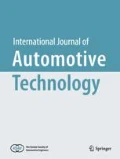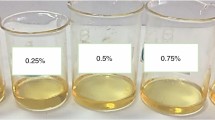Abstract
This study examined the physical and chemical properties of engine oil with a submicron-sized carbon particle lubricant mixture. Spherical carbon particles were added to engine oil to lower the friction and wear losses. In the current study, morphological and chemical analyses of these carbon particles were performed using field emission scanning electron microscopy and energy dispersive spectroscopy. The results clearly demonstrated that these spherical particles consist of a pure carbon element. In addition, the size distribution and dispersion stability of the carbon particles in the engine oil were investigated. The results revealed that the carbon particles have a diameter in the range of 200 to 700 nm, and they maintain their suspension in the engine oil for about 240 hours without using surfactants. Rheological studies were conducted to explore the effect of carbon particles on the rheological properties of the baseline oil at different temperatures and shear rates. The viscosity measurements, at temperature ranging from 5 to 60 °C, for the baseline oil and the oil-carbon particle lubricant mixture were almost identical (less than 4 % difference). Furthermore, a wettability analysis was performed to examine the effect of carbon particles on the wetting behavior of the baseline oil on a steel substrate.
Similar content being viewed by others
Abbreviations
- CA:
-
contact angle, degree
- CS:
-
carbon spheres
- s :
-
shear strain rate, s−1
- η :
-
absolute viscosity of a fluid, Pa·s
- τ :
-
shear stress, Pa
References
Alazemi, A. A., Dysart, A. D., Phuah, X. L., Pol, V. G. and Sadeghi, F. (2016). MoS2 nanolayer coated carbon spheres as an oil additive for enhanced tribological performance. Carbon, 110, 367–377.
Alazemi, A. A., Etacheri, V, Dysart, A. D., Stacke, L.-E., Pol, V. G. and Sadeghi, F. (2015). Ultrasmooth submicrometer carbon spheres as lubricant additives for friction and wear reduction. ACS Applied Materials & Interfaces 7, 9, 5514–5521.
Ali, I., Kucherova, A., Memetov, N., Pasko, T., Ovchinnikov, K., Pershin, V., Kuznetsov, D., Galunin, E., Grachev, V. and Tkachev, A. (2019). Advances in carbon nanomaterials as lubricants modifiers. J. Molecular Liquids, 279, 251–266.
Auffan, M., Rose, J., Bottero, J.-Y., Lowry, G. V., Jolivet, J.-P. and Wiesner, M. R. (2009). Towards a definition of inorganic nanoparticles from an environmental, health and safety perspective. Nature nanotechnology 4, 10, 634–641.
Bhushan, B. (2013). Introduction to Tribology. 2nd edn. John Wiley & Sons. Hoboken, NJ.
Canter, N. (2013). Lubricant additives: What degree are they removed by filtration systems? Tribology & Lubrication Technology 69, 12, 26.
Erdemir, A., Ramirez, G., Eryilmaz, O. L., Narayanan, B., Liao, Y., Kamath, G. and Sankaranarayana, S. K. (2016). Carbon-based tribofilms from lubricating oils. Nature 536, 7614, 67–71.
Gulzar, M., Masjuki, H., Kalam, M., Varman, M., Zulkifli, N., Mufti, R. and Zahid, R. (2016). Tribological performance of nanoparticles as lubricating oil additives. J. Nanoparticle Research 18, 8, 223.
Hamrock, B. J., Schmid, S. R. and Jacobson, B. O. (2004). Fundamentals of fluid film lubrication. 2nd. edn. CRC press. Boca Raton, FL.
Huang, H. D., Tu, J. P., Gan, L. P. and Li, C. Z. (2006). An investigation on tribological properties of graphite nanosheets as oil additive. Wear 261, 2, 140–144.
Joly-Pottuz, L., Dassenoy, F., Belin, M., Vacher, B., Martin, J.-M. and Fleischer, N. (2005). Ultralow-friction and wear properties of IF-WS2 under boundary lubrication. Tribology Letters 18, 4, 477–485.
Kalin, M., Kogovšek, J. and Remškar, M. (2012). Mechanisms and improvements in the friction and wear behavior using MoS2 nanotubes as potential oil additives. Wear, 280, 36–45.
Law, K. Y. (2014). Definitions for hydrophilicity, hydrophobicity, and superhydrophobicity: getting the basics right. J. Physical Chemistry Letters 5, 4, 686–688.
Li, K., Zhang, X., Du, C., Yang, J., Wu, B., Guo, Z., Dong, C., Lin, N. and Yuan, C. (2019). Friction reduction and viscosity modification of cellulose nanocrystals as biolubricant additives in polyalphaolefin oil. Carbohydrate Polymers, 220, 228–235.
Lugscheider, E. and Bobzin, K. (2003). Wettability of PVD compound materials by lubricants. Surface and coatings technology 165, 1, 51–57.
Martini, A., Ramasamy, U. S. and Len, M. (2018). Review of viscosity modifier lubricant additives. Tribology Letters 66, 2, 58.
Mistry, K. K., Pol, V. G., Thackeray, M. M., Wen, J., Miller, D. J. and Erdemir, A. (2015). Synthesis and tribology of micro-carbon sphere additives for enhanced lubrication. Tribology Trans. 58, 3, 474–480.
Miwa, M., Nakajima, A., Fujishima, A., Hashimoto, K. and Watanabe, T. (2000). Effects of the surface roughness on sliding angles of water droplets on superhydrophobic surfaces. Langmuir 16, 13, 5754–5760.
Moshkovith, A., Perfiliev, V., Verdyan, A., Lapsker, I., Popovitz-Biro, R., Tenne, R. and Rapoport, L. (2007). Sedimentation of IF-WS2 aggregates and a reproducibility of the tribological data. Tribology Int. 40, 1, 117–124.
Pol, V. G., Shrestha, L. K. and Ariga, K. (2014). Tunable, functional carbon spheres derived from rapid synthesis of resorcinol-formaldehyde resins. ACS Applied Materials & Interfaces 6, 13, 10649–10655.
Ratoi, M., Niste, V. B., Walker, J. and Zekonyte, J. (2013). Mechanism of action of WS2 lubricant nanoadditives in high-pressure contacts. Tribology Letters 52, 1, 81–91.
Selvakumar, N. and Narayanasamy, P. (2016). Optimization and effect of weight fraction of MoS2 on the tribological behavior of Mg-TiC-MoS2 hybrid composites. Tribology Trans. 59, 4, 733–747.
Tang, Z. and Li, S. (2014). A review of recent developments of friction modifiers for liquid lubricants (2007-present). Current Opinion in Solid State and Material Science 18, 3, 119–139.
Tarasov, S., Kolubaev, A., Belyaev, S., Lerner, M. and Tepper, F. (2002). Study of friction reduction by nanocopper additives to motor oil. Wear 252, 1–2, 63–69.
Will, F. (2012). Fuel conservation and emission reduction through novel waste heat recovery for internal combustion engines. Fuel, 102, 247–255.
Wu, X., Gong, K., Zhao, G., Lou, W., Wang, X. and Liu, W. (2018). Surface modification of MoS2 nanosheets as effective lubricant additives for reducing friction and wear in poly-α-olefin. Industrial & Engineering Chemistry Research 57, 23, 8105–8114.
Wu, Y. Y, Tsui, W. C. and Liu, T. C. (2007). Experimental analysis of tribological properties of lubricating oils with nanoparticle additives. Wear 262, 7–8, 819–825.
Acknowledgements
This work was supported by Kuwait Foundation for the Advancement of Sciences (PR18-15EM-03) and Kuwait University General Facility (Grant No. GE 01/07). The authors would like to thank the reviewers for their corrections and helpful suggestions.
Author information
Authors and Affiliations
Corresponding author
Additional information
Publisher’s Note
Springer Nature remains neutral with regard to jurisdictional claims in published maps and institutional affiliations.
Rights and permissions
About this article
Cite this article
Alazemi, A.A., Alzubi, F.G., Alhazza, A. et al. Rheological and Wettability Properties of Engine Oil with a Submicron Spherical Carbon Particle Lubricant Mixture. Int.J Automot. Technol. 21, 1475–1482 (2020). https://doi.org/10.1007/s12239-020-0139-z
Received:
Revised:
Accepted:
Published:
Issue Date:
DOI: https://doi.org/10.1007/s12239-020-0139-z



